Summary of The Group of Seven
The Group of Seven (sometimes referred to as the Algonquin School) was Canada's first internationally recognized art movement. The Group was united in the belief that a distinct Canadian art could be developed through direct contact with the country's vast and unique landscape. Though one can trace the influences of Impressionism, Post-Impressionism, Naturalism and Art Nouveau in their painting, stylistically the Group was rather loose-knit and was linked rather through a shared commitment to exploring the rugged Canadian wilderness and to establishing a credible national school.
Key Ideas & Accomplishments
- Farmers and industrialists, many of whom were recently arrived in the country, were intent on taming and/or beautifying the Canadian wilderness. The Group of Seven sought rather to preserve (through their art) their country's unspoiled terrain. They harnessed the new patriotic spirit amongst Canadians and in so doing vanquished the prevailing attitude that all things European were culturally superior to their North American imitators.
- In terms of a unified technique, the Group of Seven was a somewhat uneven mix. They shared, however, in the belief (learned from their Scandinavian counterparts) that the artist's personal feelings towards their natural surrounding should determine the style of the painting. The different approaches of each artist also mirrored the span and variety of the Canadian landscape.
- Arguably the most important member of the Group, Tom Thompson, died before the official naming of the Group of Seven. A man at one with his land, it was he, and his friend J. E. H. MacDonald, who did most to realize the dream of forming a national school of art that would celebrate, what was for Thompson, Canada's most spectacular and precious natural resource.
- The name "Group of Seven" was in fact something of a misnomer. During its lifespan, the Group exerted a great influence over other domestic artists and it would accommodate the work of a total of eleven Canadian artists. One might even add a twelfth name if one includes Emily Carr, one of Canada's most important modern artists. Carr attributed her artistic renaissance to her discovery of the Group of Seven. Indeed, her later career (forward of 1930) saw her specialize in Canadian native culture and the British Columbian rainforest.
Overview of The Group of Seven
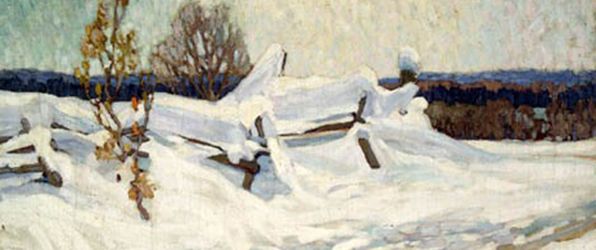
"No man can roam or inhabit the Canadian North without it affecting him" declared artist and group leader Lawren Harris. "Because of his constant habit of awareness and his discipline in expression", he added, the Canadian artist was "more understanding of its moods and spirit than others are".
Artworks and Artists of The Group of Seven
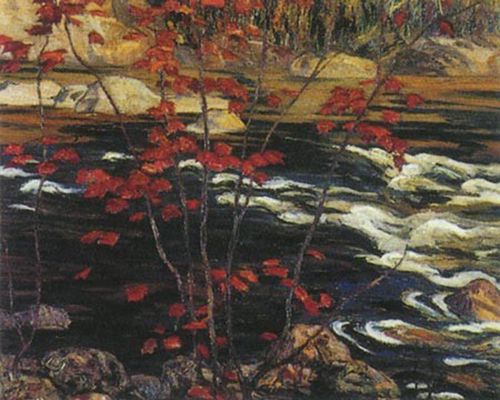
Red Maple
Born in 1882 in Montreal, Jackson left school at the age of twelve to begin work at a local printing firm. In 1906, he became a student at the Art Institute in Chicago before, a year later, enrolling at the Académie Julian Jackson in Paris. While in France he also met with plein air painters at the Étaples art colony, but, having returned home in 1912, he was so discouraged by the reception his work, he considered relocating to the United States. His fortunes turned around when J.E.H. MacDonald and Lawren Harris invited Jackson to Toronto. Having found his kindred spirits in Toronto, the patron James MacCallum offered to buy sufficient numbers of Jackson's paintings to guarantee him a year's income. Jackson became especially close to Tom Thomson and the two shared a studio, often fishing and sketching together in Algonquin Park. Jackson's landscapes, which eschewed conventional composition by extending the image to the edges of the canvas, often featured views of water seen through trees and this became a favourite subject amongst the Group.
In this dense, rhythmic image, Jackson depicts a typical autumnal scene - leaves seen hanging precariously to young branches - from Canada's Algonquin Park and the stirring rapids of the Oxtongue River. The vivid impasto red leaves seem to hover in contrast to the sinuous dark blues, and foaming white, of the water. Jackson's painting owes much to Japanese print-influenced Impressionism, the symbolist landscapes of Scandinavian painters, and the vibrating, expressionistic line of Edvard Munch. When Thomson first saw Jackson's painting at a 1913 Ontario Society of Artists exhibition, he said it opened his eyes to the possibilities of the Canadian landscape.
Oil on canvas - National Gallery of Canada
The Supply Boat
Born in Durham (England) to a Canadian father and English mother, MacDonald emigrated to Canada in 1887. He studied at the Hamilton Art School and the Central Ontario School of Art and Design, in Toronto. He began professional life as a commercial artist at the Grip Ltd. design studio where Harris persuaded him to start painting full time.
In this work, a steamboat "chugs" past a number of rowing boats, in a stylised, Oriental-like, landscape. The steam of the boat echoes the clouds and the curves of the trees which lock together like jigsaw pieces with the deep blue sky. MacDonald's commercial training is clearly visible in an image in which the graphic lines, unusual low viewpoint, and vivid blocks of colour are strongly reminiscent of Japanese prints. His treatment of the landscape reveals a further European influence in its debt to the symbolic elements of the post-Impressionists, most notably, Van Gogh and Gauguin.
MacDonald was especially revered by his colleagues as a "wonderful poetic soul, full of humour and patience". His 1911 exhibition at the Arts and Letters Club of Toronto so impressed Harris that he asked if they could work together. In January 1913, the two men attended an Exhibition of Contemporary Scandinavian Art and saw post-Impressionist and Expressionist landscape paintings by Gustaf Fjaestad and Vilhelm Hammershøi. The two men were agreed that the Scandinavian approach could offer the inspiration on which to style a different landscape art and Macdonald's former colleagues at Grip would share in this future vision for a uniquely Canadian art. MacDonald was also a writer and a volume of his poetry, West by East, was published posthumously.
Oil on canvas - National Gallery of Canada
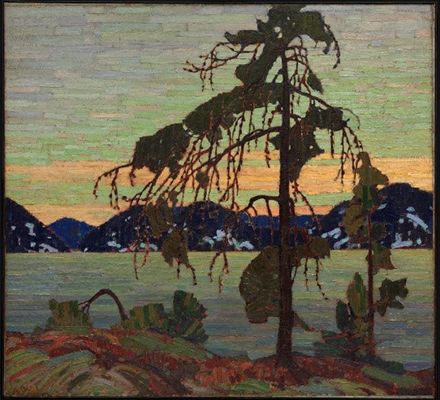
The Jack Pine
Born near Claremont, Ontario, Thomson, spent his youth exploring his natural surroundings, growing into an expert forester and canoeist. Spending most of his time at Algonquin Park, where he worked as a wilderness guide, Thomson spent his downtime painting the environment to which he had become so devoted. Having discovered new clearings ad vistas, he could disappear for days at a time to produce preparatory sketches.
The Jack Pine is probably his finest and most famous painting. He endows the lone Jack Pine tree, Canada's most broadly distributed pine, with a sentinel-like, mystical quality. The tree - outlined in red and silhouetted against a serene sunset - both bisects and connects the horizontal elements of sky, curving hills, lake and foreground. Bold, horizontal bricks of green, purple and pink decoratively describe the evening sky. Lismer described The Jack Pine as a symphony in which "[all] the instruments are playing a part, and none is out of harmony with the whole". The painting has come to symbolise Canada's hardy national identity as the tree grasps the solid rock for survival against the biting winter wind. As art critic David P. Silcox put it, the painting was one of "a galvanizing set of icons that largely define the Canadian visual identity".
Thomson's influence on the Group of Seven was crucial, both in the manner in which he celebrated the wonders of nature, and in the way he brought his environment to life through sweeping, expressive brushwork. As Harris noted, Thomson was "a part of the movement before we pinned a label on it". While working in Algonquin Park during, and soon after completing The Jack Pine, Thomson disappeared in mysterious circumstances during a canoeing trip (in July 1917). The discovery of his body a week later devastated the Group. Jackson said of the tragedy that "Without Tom, the north country seems a desolation of bush and rock [...] He was the guide, the interpreter, and we the guests, partaking of his hospitality so generously given". Despite his vital contribution, Thomson never saw the official birth of the Group of Seven.
Oil on canvas - National Gallery of Canada
Algoma Tapestry
Like many other Group members, Johnson joined Grip Ltd. as a commercial artist. Although one of its original members, his association with the Group remained somewhat brief. He participated in their exhibition at the National Gallery in 1920, but by 1921 he had left Toronto to take up the role of principal at the Winnipeg School of Art in Manitoba. Johnston bought into the camaraderie and philosophy of the group but his work proved to be the most independent stylistically. Indeed, Algoma Tapestry is typical of Johnson's preferred choice of panoramic vistas and patterns in nature.
Algoma Tapestry emerged out of the first of the famous boxcar trips Johnston, Harris and MacDonald took to Algoma. On this extended outing, the men spent a week painting the changeable landscape with Johnston himself producing 33 plein air sketches from which he produced several studio works for the exhibition. At the exhibition, the Group was still trying to convince a sceptical audience that the collected works were "evidence that Canadian artists were interested in the discovery of their own country". But since he presented a more agreeable view of the Canadian landscape, Johnston was already enjoying strong sales through his own solo shows.
Johnston was a free-spirited and strong-willed character who had long wanted to pursue his own artistic interests. Having arrived in Winnipeg, he spearheaded the largest arts exhibition the city had ever seen and even led a drive to establish art galleries in local department stores. In 1927, he changed his name from Frank to "Franz", a move that was in keeping with his shift away from his decorative style towards a greater realism and a preoccupation with representing different qualities of natural light.
Oil on panel - Private Collection
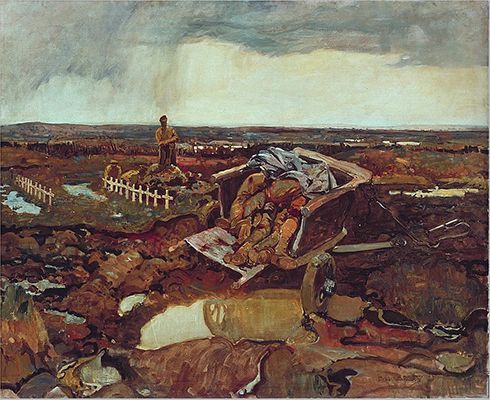
For what?
A native of Sheffield in England, Varley studied art at the Sheffield School of Art before completing his arts education at the Académie Royale des Beaux-Arts, in Antwerp. Encouraged by his childhood friend Arthur Lismer, Varley emigrated to Canada in 1912 where he soon found work in the field of commercial design. Having served, like Jackson, as an official war artist, he became increasingly interested in figurative painting though he never lost his affinity with the landscape.
In this bleak World War One image, a cart filled with dead bodies sinks slowly into the muddy soil of a devastated battlefield. Swathes of brown and ochre paint are thickly applied to recreate the texture of the churned up ground. In the distance, a more realistically rendered gravedigger leans on his shovel. Framed by a rows of graves (marked by crosses) he stands beneath a steely grey sky, the light of which is reflected in the deep puddled potholes that pockmark the barren landscape.
Varley and Jackson were both hired by the Canadian War Memorials Fund to record the country's participation in the conflict. Varley was especially affected by what he had witnessed. "We'd be healthier to forget, and that we never can", he wrote to his wife, "We are forever tainted with its abortiveness & its cruel drama - and for the life of me I don't know how that can help progression. It is foul and smelly - and heartbreaking. Sometimes I could weep my eyes out when I get despondent". Varley's vision of the landscape as a foreboding hinterland would influence the manner in which other members of the Group of Seven represented their surroundings. The artist himself developed a nomadic streak and his love of the wilderness took him to some of the remotest areas in the world including the Arctic and the furthest reaches of Russia. He returned to his adopted home in 1945, settling in Toronto for the rest of his life.
Oil on canvas - Canadian War Museum
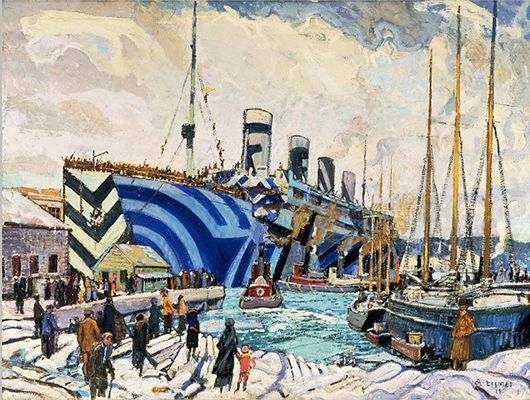
RMS Olympic in dazzle at Pier 2 in Halifax, Nova Scotia
British born Lismer emigrated from Sheffield (like Varley) to Toronto in 1911. He worked at Grip Ltd. where he met Thomson. Over the next decade Lismer often joined Thompson and the other Group members on sketching trips to Algonquin Park and Georgian Bay. Lismer was influenced by his experiences in Europe where he was inspired by the Barbizon School and the Post-Impressionists. He described adventurous wilderness treks with his painter friends as turning points in his artistic life. Lismer was an anti-establishment figure whose energy and quick-wit brough a different dimension to the Group. Indeed, he delighted his friends by creating cartoon drawings of those he/they perceived to be enemies of their Group. While his paintings often exhibited the same spiritual approach to the landscape as his colleagues, he remains better known for his paintings of ships in dazzle camouflage.
When Lismer learned that artists were being hired by the Canadian War Memorials Fund, he requested to paint Halifax, Canada's main wartime naval base. "It's intensely interesting and graphic & no one is painting it," he wrote. Lismer's well-known image of the return of Canadian personnel from the Great War shows the Olympic (sister ship of the Titanic) still bearing its multi-coloured dazzle camouflage. Despite poor light on the day that the Olympic arrived in dock, Lismer recorded the scene literally. In March 1919, he wrote: "There are [...] thousands of people who will remember that day and the painting has to be absolutely correct as to wind, weather, and tide". Lismer was a dedicated teacher and later established one of the most successful children's art programs in North America. In 1936, he set up school arts programs in South Africa and published many important articles on Canadian art.
Oil on canvas - Canadian War Museum
North Shore, Lake Superior
Harris was born in Brantford, Ontario into a wealthy conservative family. His comfortable upbringing allowed him to concentrate on his love of painting and as a nineteen-year-old he travelled to Germany where he studied for three years. He returned to Canada during the war years, teaching musketry at Camp Borden in Ontario. Following his military service, Harris was able to organize what would become his famous boxcar trips to Algoma, Ontario. The last of these trips took place in 1921, when Harris and A.Y. Jackson went to the North Shore of Lake Superior. It was here that Harris was overcome by the stark and barren landscape and the experience dictated a whole new direction that reflected his interest in Theosophy and biology and his search for deeper spiritual meaning through painting.
On a rock at the side of Lake Superior, what remains of a grey and black tree stump stands totem-like against the sky, illuminated by bands of sunlight. The stump seems to be reaching up towards the light, drawing it down to itself. Harris's image is simplified and highly stylised, with a graphic Art Deco quality. Harris's previously expressive brushwork has given way here to smooth and evenly applied paint, removing any trace of the human process; colours are used symbolically, the blue expressing transcendence and the white, unity.
Harris believed that "art is a realm of life between our mundane everyday world and the world of the Spirit". He painted versions of Lake Superior every year between 1921 and 1928, responding to views that chimed with his spiritual sensibilities. In this work, often described as the most remarkable of his career, Harris offers a metaphysical reading of the scene, rooted in his interest in Theosophical teachings; the belief that God not only created nature but is present within it. "Visible nature is but a distorted reflection of a more perfect world," Harris wrote, "and the creative individual viewing her is inspired to perceive within and behind her many garments that which is timeless and entirely beautiful".
Oil on canvas - National Gallery of Canada
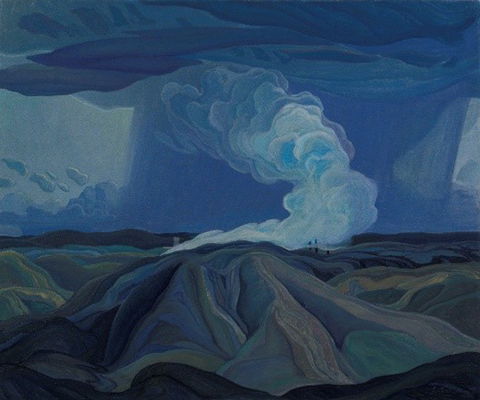
The Nickel Belt
Carmichael (the youngest member of the Group of Seven) grew up in Orillia, Ontario. Having worked in his father's shop as a carriage striper, his early foray into art saw him draw and color images of carriages. His interest in drawing took him to Toronto, where he studied art at the Central Technical School and the Ontario College of Art. Running parallel to a highly successful career as a commercial artist and designer, Carmichael gained an early reputation as a fine watercolourist, but he also used oil paints, charcoal and other mediums to render the famous locales around Ontario, including Georgian Bay and the North Shore of Lake Superior. It was, however, the La Cloche Hills, the home of the Carmichael family cottage, that became his favourite painting location.
Carmichael's later work often explored northern Ontario's mining region and The Nickel Belt is arguably Carmichael's most iconic (a most ominous) work. Hidden behind a landscape of rocky hills, an industrial complex releases its smoke into the expansive skyline. Reflecting the artist's reverence for the Northern Ontario landscape, the work carries a blunt critique of industry's impact on the natural environment to which he had dedicated his artistic life. Art historian Rosemary Donegan said of the work, "The dramatic beauty of the burnt blue-green rolling hills, seen from a bird's-eye perspective, is subverted by the distant smoke plumes and smelter stacks, which raise questions about the effect of ore smelting on the local landscape".
In commemoration of the centenary of the Group's first exhibition in 1920, the McMichael Canadian Art Collection - "the spiritual home to the Group of Seven and a destination for all Canadians who cherish the artistic legacy of the country" - planned a national exhibition featuring close to 300 pieces by all Group members across five different galleries. Announcing the landmark event, the McMichael's Executive Director, Ian A.C. Dejardin, wrote: "The Group of Seven not only translated what they saw into a vivid visual language of their own, but through that language they taught us to appreciate the natural beauty of Canada in all its vast scale and variety. Many Canadians continue to see the country through the Group's eyes, and it is thrilling to have an occasion to share the breadth and richness of the McMichael's collection with visitors on this seminal anniversary".
Oil on canvas - Ottawa Art Gallery
Beginnings and Developments
In the early years of the twentieth century Canadian art was tied to the academic tradition imported into the country by European emigres. Despite the fact that its spectacular wilderness was central to the country's sense of self identity, the Canadian wilderness was considered unpaintable and collectors expressed little interest in domestic landscape painting. Nor was there much appetite for European modernism amongst the public and collectors who tended to view the avant-garde with scorn. Thus, between 1911 and 1913 a group of painters forged a tight friendship born out of a shared dissatisfaction with the malaise that had gripped the Canadian art scene.
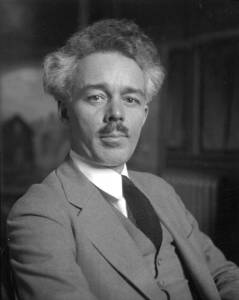
The Group of Seven included Lawren S. Harris (the Group's de-facto leader), Franklin Carmichael, Alexander Young Jackson, Frank H. Johnston, Arthur Lismer, J. E. H. MacDonald and Frederick Varley. An eighth man, Tom Thompson, is often linked to the group though passed away shortly before the group was officially formed. "The story of the Group of Seven", wrote Harris, "is that of seven artists who came together in a creative venture that no one of them could have carried through on his own". As it evolved, the Group of Seven welcomed into its ranks A.J. Casson, Edwin Holgate and Lionel LeMoine FitzGerald. Emily Carr also forged a close affiliation with the group.
According to Jackson, it was MacDonald who was "probably the first to dream of a school of painting in Canada that would realize the wealth of motifs we had all around us". MacDonald was Head Designer at Grip Ltd., Toronto's leading commercial design studio. His colleague, Tom Thomson - an enthusiastic outdoors man - encouraged MacDonald and others among their co-workers, notably Carmichael, Varley, Lismer and Johnston, to join him on weekend sketching trips to nearby lakes.
The Arts and Letters Club of Toronto became the lively focal point for the friends to lunch together, debate artistic ideas and techniques, to critique each other's works, to arrange exhibitions and attend other cultural activities. The Club brought MacDonald into contact with Harris, who was the wealthy heir to a successful farm machinery manufacturer, and close friendships were forged. "The rest of us were struggling [financially]", Casson remembered, "and [Harris] would always do little things to help us, but he did them in a nice way". Harris was a skilled organiser whose vision, determination and patronage was crucial to the emergence of the movement. Jackson recalled later that for Harris "art was almost a mission [and] that a country which ignored the arts left no record of itself worth preserving". When the group first saw paintings by the Montreal-based painter A.Y Jackson they realized the painterly potential of the uniquely Canadian landscape and MacDonald took it upon himself to write to Jackson, persuading him to move to Toronto.
The group also made an important friend in Dr. James MacCallum, an eye doctor and ophthalmologist, who was eager to support artists who shared his love of the Canadian landscape. Carmichael wrote that MacCallum, "took a keen and sincere delight in painting, and in helping painters, [not] in a charitable way, but by giving them the chance to help themselves, which is the true help".
In the summer and fall of 1912, Thomson made his first extended trip to Algonquin Park, the vast forestry reserve north of Toronto. The experience galvanized Thompson who finessed his drawing and painting skills. Though he was soon to lose his life in a canoeing accident, Thomson was an important early influence on the group. Thompson and Jackson, as Lismer noted, were having "a detached influence on the other. Thomson was "selecting his material carefully and using a finer sense of colour" whereas for Jackson the "material [...] is more intimate and suits his aggressive soul better".
In January 1913, Harris and MacDonald travelled to the Albright Art Gallery in Buffalo, New York, to attend an exhibition of Scandinavian art that included Post-Impressionist and Expressionist landscape paintings, including works by Gustaf Fjaestad and Vilhelm Hammershøi. Writing in the exhibition's catalogue, the Swedish-American critic Christian Brinton proposed a nationalistic interpretation of modern Scandinavian art, connecting the ordinary people to the land. MacDonald noted that "except in minor points, the pictures might all have been Canadian" and both he and Harris decided "this is what we want to do with Canada". The exhibition prompted Harris - who had studied art for four years in Berlin and was an enthusiast for Theosophical mysticism - to initiate a nationalist approach to landscape, as he began producing paintings through which he sought to convey his own particular response to the spiritual vibrations he felt from nature.
With a shared belief that a uniquely Canadian art style could only emerge through direct contact with its natural world, the artists carried out several expeditions together, presenting the forests and lakeshores as the true spirit of Canada. Dr. MacCallum frequently invited the artists to his cottage at Go Home Bay on Lake Huron where he would join them on their sketching trips. Early critical reaction to their work was not always positive, however. In 1913, one writer labelled them as the "Hot Mush School", whose works were "more like a gargle or gob of porridge than a work of art". An art critic for The Toronto Star even dismissed their paintings as, "a Dutch headcheese having a quarrel with a chunk of French nougat".
Conscious that most of the artists could only paint in their spare time, and in small and poorly lit quarters at that, Harris and MacCallum bought land on Severn Street in the Rosedale ravine in Toronto where they built a studio offering inexpensive studio space. Jackson and Thomson were the first to move in, followed by Harris and MacDonald. Lismer preferred to paint at home and Varley preferred to work alone. Franklin Carmichael joined the studio in the fall of 1914 with Jackson claiming that "No artist in Canada ever worked under happier conditions".
For his part, Lismer's connection with the land occurred in May 1915 during a three-week sketching trip with Thomson: "The first night spent in the North and the thrilling days after were turning points in my life [...] and above all, the companionship of a great individual, a wonder with canoe, axe and fish line".
War Years and Tragedy
The group was temporarily broken up during World War One, when Jackson and Varley became official war artists. Jackson served in France between 1915 and 1917, and was seriously injured. Harris taught musketry at Camp Borden and was discharged in May 1918 after suffering a nervous breakdown. Carmichael worked as a carriage maker and Lismer relocated to Halifax to become the principle of an art school. There he produced his famous warships series painted in dazzle camouflage. After Jackson was stationed in France, Thomson could no longer afford the studio rental on his own and moved into a small shack-cum-workshop behind the studio. He continued to spend the majority of his time in the bush working as a guide but went missing while canoeing in Algonquin Park. His untimely death devasted the group of friends.
Birth of the Group of Seven
After the war, the group reunited and recommenced their painting expeditions throughout Ontario, particularly the Muskoka and Algoma regions. Their excursions, as before, involved their working directly from nature on small birch panels, painting and drawing rapidly, especially if the weather was inclement. Finished paintings were only then worked up in the studio on their return.
With their first major exhibition looming, the group was looking for a name that both linked them and acknowledged their individualism. The common denominator was that they were a group of seven artists and so the Group of Seven was formally launched (it is thought that Harris suggested the name).
The Group was supported by Eric Brown, the director of Canada's National Gallery. In the catalogue for their first show there in May 1920, Harris stressed that for Canada to be a real home for its people, it must have its own art, free from the traditions of Europe. Two thousand people attended the show but only five paintings were sold. The critical reception was mixed. Some praised the works for the manner in which they reflected "a Canadian spirit" while others were shocked by the bold use of colour, the broad Impressionistic brush strokes, and the lack of academic precision.
Concepts and Trends
Nationalism
Greater public recognition for the Group of Seven coincided with a growth in nationalistic feeling following the War. Canada was beginning to shake off its identity as a colony, evolving into a new state with a national character all of its own. Any heightened sense of patriotism demanded appropriate national symbols and, in Jackson's words the Group of Seven contributed to the "voice of a nation speaking". Following their early scepticism, the public gradually became more open to art that celebrated Canada's natural beauty, and even though they were not the first Canadian nationalists, art historian J. Russell Harper made the point that the Group of Seven were "the first to make artists and public listen and observe". The Group presented themselves as outdoor adventurers; the custodians of their natural environment which tallied with a new "wilderness ethos" among Canadians. It was an ethos that resulted in the creation of national parks such as the Algonquin, and a boom in the building of lakeside cottages.
The Canadian Landscape
Until the Group of Seven, traditionally trained artists were left unmoved by the Canadian landscape. The Group offered a collective response to Canada's vast and varied countryside and its contrasting weather cycles. Harris noted how the land was "different in its air, mood, and spirit from Europe and the Old Country" adding that it "invokes a response which throws aside all preconceived ideas and rule-of-thumb reactions. It has to be seen, lived with, and painted with complete devotion to its own life and spirit before it yields its secrets". Not so much engaged with the search for naturalism, then, the Group sought to represent how the shifting landscapes of Canada touched their senses. Indeed, MacDonald stated that the Group's aim was "to paint the soul of things [...] the inner feeling rather than the outward form".
For the Group of Seven, the landscape became akin to a religion. Varley and Harris particularly venerated nature, finding God's immanence within it. From their paintings, Dr. Salem Bland, a leading liberal theologian, stated that he felt, "as if the Canadian soul was unveiling to me something secret and high and beautiful which I had never guessed; a strength and self-reliance, depth and mysticism I had not suspected". The Group's subjects were chosen for their grandeur and beauty and MacDonald told his students, "Think big, be generous, don't fiddle, enlarge yourselves". At the same time, the Group's paintings captured the Canadian wilderness in all its sublime solitude and tranquillity.
Techniques
The Group of Seven referred to themselves as "adventurers in paint". Theirs was a Post-Impressionist style (Gauguin, Van Gogh and Munch were amongst the European artists they admired) that could accommodate the aesthetic inclinations of Art Nouveau. Though he was taken from them before the Group was formally constituted, Thomson was perhaps the most innovative and influential of the party, working intuitively and bringing a strength and simplicity to his paintings. Following MacDonald and Harris's introduction to Scandinavian art in 1913, meanwhile, line, colour, contour, and texture became the means by which the Group might fully expresses their absorption into the landscape. In acknowledging a debt to the Group's Scandinavian counterparts, MacDonald stated that they "seemed to be a lot of men not trying to express themselves so much as trying to express something that took hold of themselves".
He made the observation that the Scandinavians "began with nature rather than with art". It was an important distinction that meant that the Group was not beholden to a set of specific aesthetic codes and was free to experiment with animated colors, heavy impasto and expansive brush strokes. The surface patterning would thus produce a highly personal response to the "untouched" Canadian landscape that could be at once stripped back and/or dynamic. Jackson noted that one of Harris's attempts to achieve a more vibrant palette "was to drag his brush quickly through three or four colors and slap it on the canvas. Among ourselves it was known as tomato soup". In 1921, after a trip to Lake Superior's north shore, Harris simplified the colour and composition of his works, soon to be followed by MacDonald, Carmichael and Varley. The pigment was thinner and the landscape more abstracted and stylized, ethereal even, and quite similar to Art Deco graphics. By the middle of the decade, Harris's subjects were almost monochromatic, presaging the artist's move towards total abstraction.
Other Members and Affiliates
Once established, three other artists became Group members. Alfred Joseph Casson was working in Toronto as a freelance commercial designer at Rous and Mann when Carmichael took him under his wing. A superb watercolourist, Casson, with Carmichael and F.H. Brigden, founded the Canadian Society of Painters in Water Colour in 1925 before he accepted Carmichael's invitation to join the Group of Seven the following year.
Raised on a Manitoba farm, L.L. (Lionel LeMoine) FitzGerald developed a love for Canada's Prairies. Reflecting his deep ties to his home region, he chose simple subjects for his paintings and gained recognition for his Prairie scenes, paintings of his neighbour's backyard, and potted plants. When it disbanded in 1932, FitzGerald became one of the founding members of the Group of Seven's successors, the Canadian Group of Painters. For his part, Edwin Holgate, a childhood tutee of the Canadian Impressionist and teacher William Brymer, spent several years in Paris before returning to Canada in 1922 where he opened a design studio. Holgate's talents as a graphic artist and wood engraver soon began to attract the attention of the Group, and though perhaps better known for his portraits, Holgate painted several impressive murals including those for the famous Totem Pole Room at Ottawa's Château Laurier Hotel. In 1925, Holgate played a key role in the founding of the Canadian Society of Graphic Artists and, after the Group of Seven's demise, took up a key teaching position at the Art Association of Montreal.
Further Developments
Art historian Dennis Reid has noted of the Group of Seven (and notwithstanding the country's impressive contribution to the international music scene carried by figures of the lofty stature of Leonard Cohen, Joni Mitchel and Neil Young) that "they occupy a position in the Canadian cultural pantheon shared only with a few hockey stars and a handful of beloved politicians". Ian A.C. Dejardin, Executive Director of the McMichael Canadian Art Collection wrote that "The Group of Seven not only translated what they saw into a vivid visual language of their own, but through that language they taught us to appreciate the natural beauty of Canada in all its vast scale and variety. Many Canadians continue to see the country through the Group's eyes". A 1995 National Gallery exhibition titled, The Group of Seven: Art for a Nation, also espoused the view that the Group of Seven offered "an essential Canadian identity". However, some liberal critics have questioned any national identity rooted in white, male, English-speaking painters of European descent whose romanticised engagement with the outdoors paid no attention to its First Nations People (nor, indeed, any people at all).
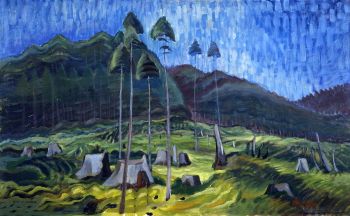
Foremost among the significant Canadian artists to be influenced by the group was Emily Carr. On her way to Ottawa for the 1927 exhibition Canadian West Coast Art: Native and Modern - in which she showed 26 of her works - she met Varley, Lismer, Jackson, MacDonald and Harris, who re-energized her pursuit of a unique artistic vision. Her response to seeing their paintings was, "Oh, God! What have I seen? Where have I been? Something has spoken to the very soul of me, wonderful, mighty, not of this world, Chords way down in my being have been touched". Other artists who came under the influence of the Group of Seven was their contemporary, the printmaker David Milne, a man described by art critic Clement Greenberg as one of the three greatest North American artists of his generation. The Canadian abstract painter Jack Bush began his career painting landscapes inspired by the Group of Seven, while the Scottish painter Peter Doig (a long-time resident of Canada) drew much of the inspiration for his paintings from the Canadian landscape and the Group's legacy.
Useful Resources on The Group of Seven
-
![The Group of Seven]() 63k viewsThe Group of SevenIntroductory video from the Art Gallery of Ontario
63k viewsThe Group of SevenIntroductory video from the Art Gallery of Ontario -
![Painted Land: In Search of the Group of Seven]() 0 viewsPainted Land: In Search of the Group of SevenAuthor and wilderness photographer Joanie and Gary McGuffin and art historian Michael Burtch find the actual locations that inspired the Group of Seven
0 viewsPainted Land: In Search of the Group of SevenAuthor and wilderness photographer Joanie and Gary McGuffin and art historian Michael Burtch find the actual locations that inspired the Group of Seven -
![Group of Seven]() 17k viewsGroup of SevenDocumentary by Katherine Jeans
17k viewsGroup of SevenDocumentary by Katherine Jeans -
![Steve Martin gets serious about new Lawren Harris exhibit]() 12k viewsSteve Martin gets serious about new Lawren Harris exhibitCBC news item with Hollywood star
12k viewsSteve Martin gets serious about new Lawren Harris exhibitCBC news item with Hollywood star -
![One-on-one with A. J. Casson]() 1k viewsOne-on-one with A. J. CassonCTV interview in 1978 with last survivor of the Group of Seven
1k viewsOne-on-one with A. J. CassonCTV interview in 1978 with last survivor of the Group of Seven
-
![Canadian Landscape with A. Y. Jackson/Lismer/Varley]() 3k viewsCanadian Landscape with A. Y. Jackson/Lismer/VarleyThree short documentaries from the National Film Board of Canada
3k viewsCanadian Landscape with A. Y. Jackson/Lismer/VarleyThree short documentaries from the National Film Board of Canada -
![Lawren Harris: Canadian Visionary]() 22k viewsLawren Harris: Canadian VisionaryExhibition introduction for the Vancouver Art Gallery
22k viewsLawren Harris: Canadian VisionaryExhibition introduction for the Vancouver Art Gallery -
![The Materials and Techniques of J.E.H. Macdonald]() 2k viewsThe Materials and Techniques of J.E.H. MacdonaldExploration of Macdonald's work by the Canadian Conservation Institute
2k viewsThe Materials and Techniques of J.E.H. MacdonaldExploration of Macdonald's work by the Canadian Conservation Institute -
![West Wind: The Story of Tom Thomson]() 5k viewsWest Wind: The Story of Tom ThomsonIntroduction to the artist who inspired the Group of Seven
5k viewsWest Wind: The Story of Tom ThomsonIntroduction to the artist who inspired the Group of Seven -
![Emily Carr: A Woman of All Sorts]() 11k viewsEmily Carr: A Woman of All SortsCBC Life and Times documentary
11k viewsEmily Carr: A Woman of All SortsCBC Life and Times documentary
 Ask The Art Story AI
Ask The Art Story AI
















